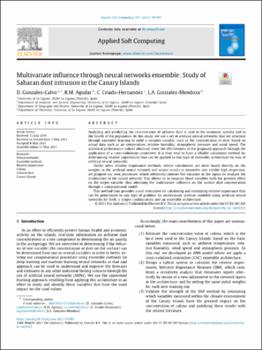Multivariate influence through neural networks ensemble: Study of Saharan dust intrusion in the Canary Islands
Date
2021Abstract
Analyzing and predicting the concentration of airborne dust is vital to the economic activity and to
the health of the population. In this study, we use a set of artificial neural networks that we structure
through ensemble learning to yield a complex variable, such as the concentration of dust, based on
actual data such as air temperature, relative humidity, atmospheric pressure and wind speed. The
statistical performance indices obtained, show the effectiveness of the proposed approach through the
application of a cross-validation committee. It is thus vital to have a reliable calculation method for
determining relative importances that can be applied to this type of ensemble architecture by way of
artificial neural networks.
Unlike other relative importance methods, where calculations are done based directly on the
weights in the artificial neural network and whose results in ensemble sets exhibit high dispersion,
we propose our own procedure, which selectively chooses the variation in the inputs to readjust the
architecture of the neural network. This allows us to measure those variables with the greatest effect
on the target variable, thus obtaining the multivariate influence on the surface dust concentration
through a computational model.
This method thus provides a real alternative for calculating and estimating relative importance that
can be generalized to any type of problem for multivariate systems modeled using artificial neural
networks for both, a simple configuration, and an ensemble architecture






